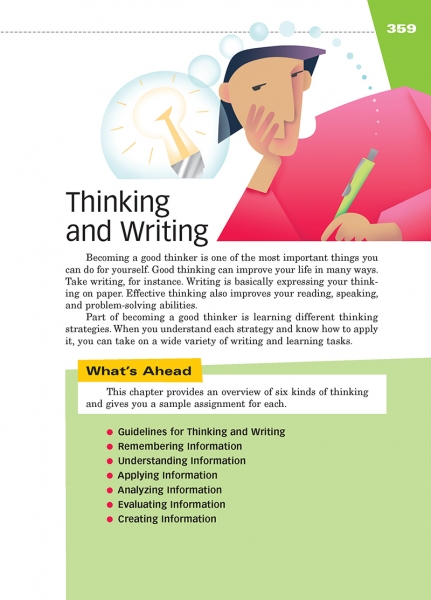Page 359 from

Start-Up Activity
Bring an interesting prop to class (perhaps an ugly home decoration, a slightly unsettling toy, an unusual piece of furniture, or some other weird object that will engage students). Hold up the prop and give a command:
-
Describe this.
Have one or two volunteers describe it. Then give another command.
-
Name the parts of this.
Have one or two volunteers do so. Continue giving commands and taking responses.
-
Put this thing into a category.
-
Tell what it is worth and why.
-
Compare this to something else in the room.
-
Guess where this came from and why it is here.
-
Tell me something that you could use this for.
-
Tell me how you could use this to make something new.
Afterward, point out all of the different ways that students have been thinking about the prop: classifying, comparing and contrasting, tracing causes and effects, evaluating, applying, and creating. Point out how much better the students understand the thing now than when you first presented it.
In the same way, students can use many different thinking strategies to explore anything they are learning about. They will discover these strategies on the next pages.
Think About It
“He who learns but does not think, is lost! He who thinks but does not learn is in great danger.”
—Confucius

Start-Up Activity
Bring an interesting prop to class (perhaps an ugly home decoration, a slightly unsettling toy, an unusual piece of furniture, or some other weird object that will engage students). Hold up the prop and give a command:
-
Describe this.
Have one or two volunteers describe it. Then give another command.
-
Name the parts of this.
Have one or two volunteers do so. Continue giving commands and taking responses.
-
Put this thing into a category.
-
Tell what it is worth and why.
-
Compare this to something else in the room.
-
Guess where this came from and why it is here.
-
Tell me something that you could use this for.
-
Tell me how you could use this to make something new.
Afterward, point out all of the different ways that students have been thinking about the prop: classifying, comparing and contrasting, tracing causes and effects, evaluating, applying, and creating. Point out how much better the students understand the thing now than when you first presented it.
In the same way, students can use many different thinking strategies to explore anything they are learning about. They will discover these strategies on the next pages.
Think About It
“He who learns but does not think, is lost! He who thinks but does not learn is in great danger.”
—Confucius